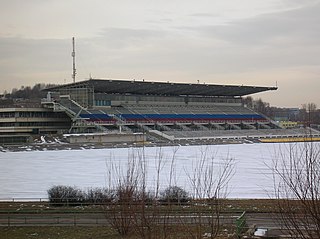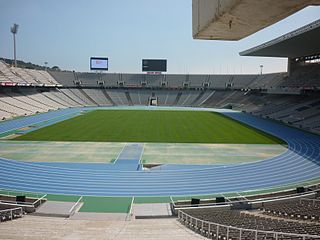
The Stadio Artemio Franchi is a football stadium in Florence, Italy. It is currently the home of ACF Fiorentina. The old nickname of the stadium was "Comunale". When it was first constructed, it was known as the Stadio Giovanni Berta, after Florentine fascist Giovanni Berta.
For the 1956 Winter Olympics in Cortina d'Ampezzo, Italy, a total of eight sports venues were used. All of the venues used were new or rebuilt. To make use of television coverage for the first time in the Winter Olympics, the cross-country skiing stadium was constructed to allow the best coverage. Five of the venues used for these games would appear in the James Bond film For Your Eyes Only twenty-five years later.
For the 1964 Summer Olympics, a total of thirty-three sports venues were used. Six of the venues were built before the International Olympic Committee awarded the 1964 Games to Tokyo in 1959. This included two venues that hosted the 1958 Asian Games. There were thirteen new, eight temporary, and five reconstructed and/or renovated venues that were used during the event. During the Olympics, wind and weather had issues with two athletic events. After the Olympics, one venue hosted both a FIFA World Cup and a World Athletics Championship event while another also hosted a World Athletics Championship event.

For the 1968 Summer Olympics, a total of twenty-five sports venues were used. Most of the venues were constructed after Mexico City was awarded the 1968 Games. Mexican efforts in determining wind measurement led to sixteen world records in athletics at the University Olympic Stadium. All four of the football venues used for these games would also be used for both of the occurrences that Mexico hosted the FIFA World Cup, in 1970 and 1986.

For the 1980 Summer Olympics, a total of twenty-eight sports venues were used. The first venue used for the Games was built in 1923. With the creation of the Spartakiad in Moscow in 1928, more venues were constructed. Central Lenin Stadium Grand Arena was built in 1956 for that year's versions of the Spartkiad. A plan in 1971 to construct more sports venues by 1990 was initiated, but accelerated in 1974 when Moscow was awarded the 1980 Games. The new venues to be used for the Games were completed in 1979. During the Games themselves at the permanent road cycling venue, the first ever constructed, the largest margin of victory was recorded in the individual road race cycling event since 1928. The Grand Arena hosted the football final that was played in a rainstorm for the third straight Olympics. After the 1991 break of the Soviet Union, the venues in Kiev, Minsk, and Tallinn would be located in Ukraine, Belarus, and Estonia, respectively. Luzhniki Stadium, formerly Grand Arena, continues to be used, and it was affected by the Luzhniki disaster in 1982. The stadium served as host for the IAAF World Championships in Athletics in 2013. Another venue, the Moscow Canoeing and Rowing Basin, served as host to the ICF Canoe Sprint World Championships in 2014. In December 2010, Russia was awarded the 2018 FIFA World Cup with Luzhniki Stadium and Dynamo Stadium proposed as venues for those events.

For the 1984 Summer Olympics, a total of thirty-one venues were used. The Los Angeles Memorial Coliseum and the Rose Bowl, two venues previously used for the 1932 Summer Olympics, were used for the 1984 Games. Between the 1932 and the 1984 Summer Olympics, the expansion of professional sports teams assisted in the growth of the facilities that would be used for the 1984 events. Only two new permanent venues were constructed, both using corporate sponsorship, though neither were mentioned in the official Olympic report. Many other venues had temporary adjustments and returned to their normal usage once the 1984 Olympics were completed. Stanford Stadium in Palo Alto and the Rose Bowl later served as venues for the Super Bowl, the FIFA World Cup, and the FIFA Women's World Cup.

For the 1992 Summer Olympics in Barcelona, a total of forty-three sports venues were used.

For the 2006 Winter Olympics in Turin, Italy, a total of fifteen sports venues were used. Venue construction ran from 2002 to 2005. Cesana Pariol had to have turns 17 and 18 modified following the Luge World Cup in January 2005, but they were not cleared out until October 2005. Winds postponed the Nordic combined team event for a day. Many of the venues served as host for the Winter Universidade the following year.





